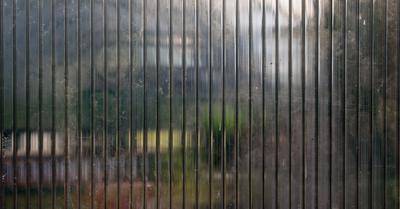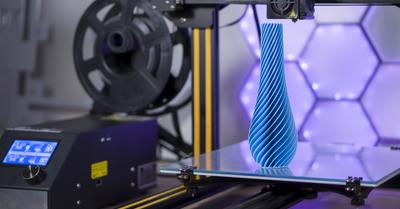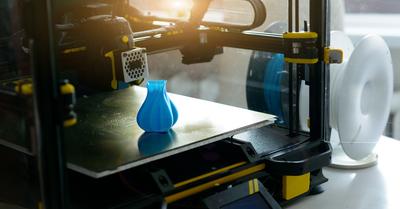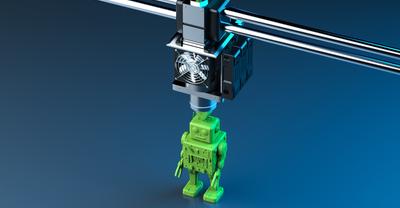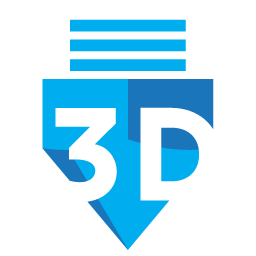3D Printer Delta Vs. Cartesian
Alright, we have mentioned that the way the printing head moves is different, but there are a few other differences. For instance, the look of each printing device is different! Delta has a circular print bed because the rotation tends to be more circular as well; this means square objects don’t turn out as sharp.
With a Cartesian 3D printer, it is moved by one massive block that is squared shape; this lets items be sharper, and, in this case, circular objects do not turn out as good. Both printers do an equally good job of printing, but it depends on the shape of the object you are going for.
What Is the Process For 3D Printing with Delta and Cartesian
3D printing is called additive manufacturing and both Delta and Cartesian printers have the same process. They layer material on top of each other until the object is complete.
Design and Edit
The first step is to use a CAD (computer-aided design) software program that allows designing in 3D. You can either scan and import an object and then edit it. You can design from scratch. Or, you can purchase a 3D model already created.
There are many online software programs available to use for free. Typically, they allow you to design for free but then require you to pay to export the correct file to actually print.
The market is becoming very competitive so finding resources isn’t difficult.
Slicing
Once you have the design or object you need to save it as an STL file type. This is the file type most 3D printers recognize. An STL file adds instructions within that make it able to communicate with the 3D printer. The machine will follow your exact instructions, so it is crucial to do this step well.
Slicing in simple terms means separating the 3D file into thousands of layers for the 3D printer to follow. As mentioned above, 3D printers print out in thin layers that add up to be a total product
Printing
This seems like the most fun step, and it is but, depending on how big your object is, it will take time to print so be patient. Once the printing has begun and everything appears to be working properly you can leave and return later to see your masterpiece.
Finished Product!
The finished product is like getting a gift, it’s exciting. All that is left is to remove it from the print bed. Some objects are easy to remove, others a little more difficult depending on the bed platform. The best news is, once it is off, you can put the object to work or display whatever the purpose.
These are the most basic steps needed to 3D print an object. Printing can be easy; most of the work is straightforward enough for anyone to use. Even getting objects to print has become easy, given all the people designing and publishing their designs. You are likely able to find anything you want.
The Price Difference Between Delta and Cartesian
There are so many kinds of 3D printers that fall into each of these two categories so you just have to pick the price that works within your budget and settle on one. Just remember a printer meant for manufacturing will be much more expensive than one for personal use.
Some printers are meant for small intricate pieces, others are meant to create giant replicas. The good news is there is a 3D printer for every need now.
Delta Style Printer Options
The delta style printer offers a wide selection of printer styles, all ranging in different prices. It can range between $150 and $2,600. Sometimes more! It all depends on what you need to be done, how fast you need it done. Here are some Delta 3D printer options.
Monoprice Mini Delta
This is one of the more budget-friendly options starting at $160 to $300. It can only print smaller items and has a slower speed of 150 mm per second.
FLSUN QQ-S
This sleek-looking machine is a step above the mini Delta printer. Its cost can range between $300 and $360. It produces objects with a maximum height of 50 microns, and the building plate is 260×320 mm.
Delta Wasp 240 Pro
This is an excellent Delta style printer and will give you options to use many different materials. It has a building plate of 200×400 mm, and the maximum building height is 50 microns.
The cool thing about this machine is that it goes much faster than the other two printing at speeds of up to 500 mm/s. The price for this extravagant machine is $2,600 and $3,800 but may be worth every penny.
Cartesian Style Printer Options
Cartesian style printers are the most common 3D printers you will find people using. It is straightforward to use, but does look different and provides a different kind of building plate. This can also be found for a few hundred to a few thousand dollars.
Creality Ender 3
This one is a fundamental 3D printer starting at $167 though maybe more depending on who you buy it from. The build volume or maximum size is 220x220x250mm. You can make the item as detailed as you want, and an entire toolkit comes with this printer. This is great for beginners.
Formlabs Form 3L SLA
A tad bit more expensive with a price tag of $9,999, but it is really meant for manufacturing professionals needing a quick turnaround. It is also good for printing square pieces. It comes with everything you need.
Remember, both Delta and Cartesian are styles of printers you can purchase and print equally well detailed objects. For the most part, it is how they are built. You will find many very reputable companies to choose from regardless of the style you pick.
How 3D Scanning Works with Delta and Cartesian 3D Printers
3D laser scanning is one of the most impressive inventions of our time. It partners with 3D printing well simplifying the effort required to produce a 3D design of a specific object.
3D scanning was created for researchers and designers who needed to create and recreate exact surfaces. The technology was first introduced in the 1960s with that intent, but was not well adopted until the late 1990s when a lot of the kinks were worked out of the technology.
Today you can find many styles of 3D laser scanning devices, all of which aim to help the design process. You can find it as a handheld device, or even on a moving device. All a user has to do is hold the scanner and move slowly around an object.
Capturing every angle is what improves the quality of the scan. Once the scan is created it can be moved through a cloud server like most files these days and can be sent directly to your 3D software.
Think of the latest apple iPhone and 3D recognition. 3D laser scanning is much like this. The device takes hundreds and sometimes thousands of pictures of an object as the laser beam bounces and roams over the object measuring every square inch with light.
3D laser scanning is incredibly accurate, even picking up small details that would take humans hours to detect and recreate.
Beware, you will get exactly what the object displays, like scratches, holes, textures, even that of black surfaces that can be hard to see, colors, angles, and all dimensions. This is one of the best ways to 3D print an exact replica of something. You see now why 3D scanning is a perfect fit with 3D printing.
Who Should use 3D Printing and Scanning?
Many people worldwide have adopted the use of this technology because of the incredible uses these tools provide. Many professionals have used this tool to help upgrade our lives, protect our people, and even put away bad guys. Who else can use these tools?
Forensic Investigators
Many people have realized that you can make 3D models from printers, and you can use 3D laser scanning equipment to make virtual reality! Every ounce of evidence can be collected, and it can be enhanced so much a jury can walk through a crime scene exactly how the investigators found it when they showed up. On top of that, they can take footprints, fingerprints, and create replicas of them through 3D printing to help identity, which was at the crime scene.
Police Departments
Police around the world are using 3D scanning to solve traffic accidents. By putting 3D laser scanning devices in stop lights they can review accidents in real-time showing who is at fault, all parties involved including license plates.
With the information in real-time, all the information is there to recreate 3D models or replicas for use in court cases as needed.
Architects
Architects are known for making unique and monumental buildings with angles and shapes that may appear unsafe. 3D printing can now help them test their designs by printing them in miniature prior to building. Flaws and weaknesses can be resolved in a faster manner.
Artists
Many creative people have started using 3D printing to create stunning pieces of art. An artist can capture exact facial features, and then 3D print statues of actual people creating amazing monuments. They can also print different objects to make different layers of art and sculptors.
Students
Though this one if not a profession, it does help students! If they have access to a 3D printer, they can access free CAD and even 3D scanners through their cell phones.
This allows them to scan, create, and print. It is a different way to learn about the surrounding environment. It allows them to study the real world in a different way.
Archeologists
The most amazing feature of these tools is that they are completely noninvasive. This makes it great for archeologists to scan bones, and then print exact copies to study. 3D laser scanning makes it easy to pick up every microscopic detail and really dig into the bones’ secrets.
These replicas can be handled and sent to museums around the world while the original ones can stay wherever they were found. 3D printers and scanners create a way to communicate with each other through physical objects.
Many more people are adopting these tools, not just professionals but also anyone who takes an interest in technology. 3D printers and scanners are creating competitive markets, and many people are focused on providing the fastest 3D printers, with the best features.
The Pros and Cons of Cartesian and Delta Printers
So, we have discussed how popular 3D printers and scanners are but back to the pros and cons of Cartesian vs Delta printers.
Cartesian Pros
Support
Due to this being one of the most popular types of 3D printers, there is a huge network of people who use them.
You will be able to find help, chat groups, tech support, and more with this printer. That makes it really good for a beginner.
Kits
Most of these printers come with specific instructions and toolkits that will help you learn how to use this machine properly.
Surface Finish
The finish on products is way better than a Delta printer because it has a rigid axis which a Delta does not possess. This means there is less room for error because of the limited space the nozzle can move.
Cartesian Cons
Popularity
Since these have been around for a lot longer than Delta, there are a lot of models on the market that are low quality. You have the beauty of finding as many as you want, that doesn’t mean it will be good or produce objects that you want.
Kits
Not all brands create toolkits that come with everything. You will need to see what the 3D printer comes with. You may end up spending a lot of money to realize you need a $2,000 piece.
Delta Pros
Print Beds
They have circular print beds and 3 arms that can move the nozzle in all directions. This gives you more space to print, and more unique shapes to print out.
Timely
Okay, admittedly, this printer is much faster than a cartesian printer. Both are somewhat faster than making an object by hand, but Delta takes the cake on this advantage.
Length
Due to the arms and height of this printer, it can print much taller or smaller objects than a cartesian. You have more control over how high an object goes.
Cons of Delta
Speed
Due to the printer’s speed, things can come out not as precise as you want. There will be times you will have to print multiple times to get the perfect object. More speed means less precision.
Square
If you are an architect trying to make a square house model, this is not the printer for you. Yes, it can make a square but not precisely. Due to the roundness of the structure, square shapes come out a little wonky.
Both delta and cartesian type printers are good choices and have an equal number of pros and cons; it boils down to buyer beware. Do your homework and you will likely find one that negates some of the negatives.
Which 3D Printer Should You Choose?
Both of these printers will exceed your expectations if you choose one from a reputable brand. You can’t go wrong with either, but it will depend on how much work you want to put in assembling the 3D printer.
Cartesian printers typically come ready to use out of the box. Everything is assembled. All you have to do is feed it instructions. A delta printer will come with everything you need, but you will have to assemble it.
If you are in a rush to create something, go for a standard cartesian printer. If you want to see how it works and put it together yourself, buy a Delta!
Final Thoughts
3D printing is so extraordinary. It can turn a 3D file into a physical object and that it is an insane thought. 3D laser scanning has allowed us to create a magical world and then print it. We are becoming safer; we are learning ways to share information with this technology. Who knows where it could lead? We have been slowly adopting these tools and using them to update and upgrade our entire world.



